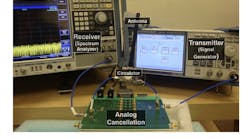Full-duplex radio technology has the potential to double bandwidth, which would obviously have huge implications for wireless-network designs—potentially halving the spectrum needs of cellular networks. A startup out of Stanford has come up with a design that makes the full-duplex radio an actual possibility by achieving total cancellation of self-interference. The in-band, full-duplex WiFi radio can simultaneously transmit and receive on the same channel using standard IEEE 802.11ac technology and a single antenna. Novel analog and digital cancellation techniques are used to cancel the self-interference to the receiver noise floor, thereby ensuring no degradation to received signals.
This file type includes high resolution graphics and schematics when applicable.
In a paper titled “Full Duplex Radios,” Kumu Networks’ Dinesh Bharadia, Emily McMilin, and Sachin Katti describe the design and implementation of a full-duplex WiFi radio that provides 110 dB of self-interference cancellation for standard WiFi signals. The wideband radio works with the widest bandwidths (80 MHz) and data rates used by the latest IEEE 802.11ac physical-layer (PHY) standard in the 2.4-GHz spectrum. The team also experimentally demonstrated a complete, full-duplex communications link, whereby they nearly achieved the theoretically expected double throughput.
Two of the founders of Kumu Networks, Jung-Il Choi (left) and Mayank Jain (right), working on the circuit.
According to the researchers, “Since WiFi signals are transmitted at 20 dBm (100 mW) average power, and the noise floor is around –90 dBm, the transmit self-interference has to be canceled by 20 dBm – (–90 dBm) = 119 dB to reduce it to the same level as the noise floor and render it negligible. If self-interference is not completely canceled, any residual self-interference acts as noise to the received signal and reduces SNR and consequently throughput.”
At best, previous full-duplex designs provided 85 dB of cancellation, which leaves about 25 dB of residual self-interference. This reduces the signal-to-noise ratio (SNR) in each direction of the full-duplex link by 25 dB. Prior designs also utilized two antennas, which actually weakens the argument for full duplex approaches. After all, the same doubling of capacity could be obtained by using the two antennas in a multiple-input multiple-output (MIMO) approach to spatially multiplex two independent packets in half-duplex mode instead of using them for full duplex.
The paper goes on to describe the design and implementation of a key part of the design: the use of both analog and digital cancellation. “…We design a novel programmable analog cancellation circuit using off-the-shelf components that allows us to…dynamically cancel the self-interference. Such analog cancellation prevents receiver saturation from strong self-interference and allows us to use commodity radios. However, the analog cancellation does not completely cancel the self-interference. We complement it with a novel digital cancellation algorithm and implementation that cancels any remaining self-interference. Our digital cancellation algorithm differs from all prior work because it not only models the linear distortions, but also nonlinear effects and other special effects, such as oscillator noise. Thus, overall we use a hybrid analog-digital design that successfully models all linear and nonlinear distortions as well as transmitter noise.”
The system was deployed in an indoor, noisy office environment in the 2.4-GHz Industrial, Scientific, and Medical (ISM) band. The WiFi PHY was used over 80 MHz on RS radios and over 20 MHz using WARP radios. In practice, it delivered a median throughput gain of 87%, which is close to the theoretically expected 2X. In terms of cancellation, the design consistently delivered the required 110 dB needed for linear self-interference cancellation. The researchers note that their architecture is not novel, as similar ones have been proposed before. But their design of cancellation circuits and algorithms is the only one to achieve the necessary amount of cancellation at these performance levels.
Future research will help flush out related problems, such as the size of the circuit and adapting the design to work with Long Term Evolution (LTE) technology. The current prototype board measures a cumbersome 10 x 10 cm, which is far too large to implement on phones or other portable devices. If full-duplex technology is ever to be realized on these devices, significantly smaller boards need to be designed through the use of delay lines like LC ladders. Because LTE uses smaller channels than WiFi, different cancellation numbers also are necessary. LTE’s 20-MHz channel does simplify the cancellation problem, however.
This file type includes high resolution graphics and schematics when applicable.


